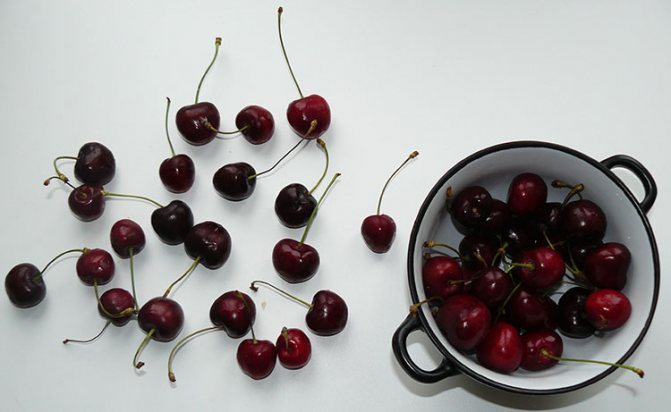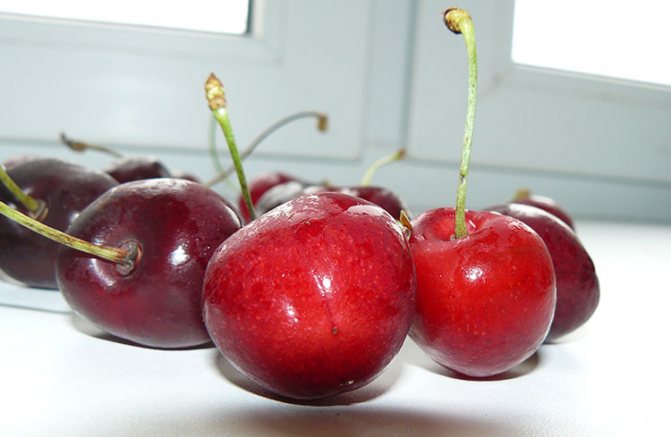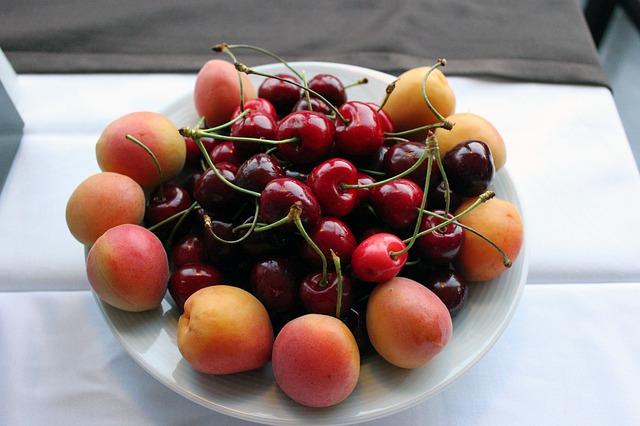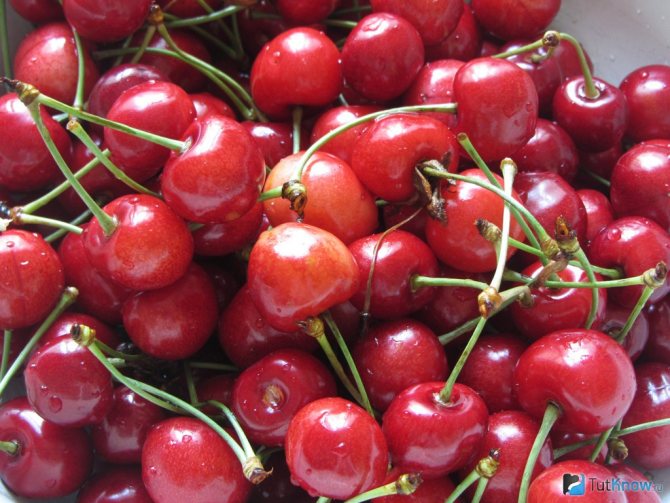Chemical composition of cherries
So, from a botanical point of view, the cherry fruit is a drupe, but we are all accustomed to considering it a berry.
Nutritional value per 100 grams:
- Calorie content – 50 kcal per 100 grams of product with stone. The calorie content of pitted cherries will be slightly higher
- Proteins – 1.1
- Fats – 0.4
- Carbohydrates – 10.6 (most of them are glucose and fructose)
Content of vitamins, micro- and macroelements per 100 grams:
| Contents per 100 grams | % RDI (% of recommended daily intake) | |
| Vitamin C | 15 mg | 17% |
| Iron | 1.8 mg | 10-20% (women and men, respectively, since women’s need for iron is almost 2 times higher than that of men) |
| Potassium | 233 mg | 9% |
| Magnesium | 24 mg | 6% |
The content of other useful substances is more modest, less than 5% of the recommended intake. Among them:
- Vitamin A, Beta Carotene;
- Vitamin E;
- Vitamins B1 and B2;
- PP;
- Calcium, Sodium, Phosphorus.
Cherry season
The main season is from the end of May to the end of June. It is at this time that the berries are the cheapest and there are really a lot of them. Then the yield gradually declines and fewer berries can be found in the markets. However, late varieties produce a harvest by early August. So cherry lovers can enjoy it for about 1.5 months out of the year.
Planting cherries: rules and features
If you still don’t have cherries in your beautiful garden, be sure to plant them! In addition to the fragrant aroma of flowers, later you will thoroughly enjoy the aromatic cherries, which, moreover, have enormous health benefits. Since it is one of the first to bloom and bear fruit, plant it in a bright place. The soil should not be swampy or oversaturated with moisture.
The planting hole is made deep - approximately 70x70 and 60 cm. The distance between the trees is at least 3 meters. Mix a bucket of sand, some wood ash, a bucket of peat, clay and any organic fertilizers in the hole. This is done to ensure that the cherries grow and bear fruit normally.
After planting, thoroughly compact the soil and cover it with compost or dry grass. For benefit, feed with fertilizer in the form of ash and slurry. This must be done before flowering, in May and after harvesting the fruits (old trees are fertilized 3-4 times). Don’t forget to prune it annually, removing dry, weak, inward-facing branches. Treat the cutting area with garden varnish.
Video about pruning cherries:
The benefits of cherries for the human body
An important chemical compound found in cherries is anthocyanins, which belong to the group of flavonoids.
It is anthocyanins that determine the dark color of berries (red, blue, purple). 100 grams of cherries contain 350-400 mg of anthocyanins. Sweet cherries are one of the most anthocyanin-rich foods.
Anthocyanins have powerful antioxidant activity and antitumor effects.
How it works? Anthocyanins block angiogenesis, that is, the formation of new blood vessels. As is known, in tumor tissues there is a constant growth of blood vessels feeding the tumor, which leads to its indomitable growth. Consumption of anthocyanins blocks this process. Of course, if a person already has a tumor, anthocyanins will not help, but their use as a preventive measure is highly recommended.

Other useful properties of the product:
- The high content of pectins enhances intestinal motility, removes harmful substances and cholesterol from the body.
- The relatively high iron content makes the product useful for increasing hemoglobin levels (however, you should be aware that the main source of iron is still meat).
- The fairly high content of potassium and magnesium makes cherries beneficial for the heart. These substances are responsible for the normal functioning of the heart muscle. Potassium removes sodium, that is, salt, from the body (the acid-base balance is maintained), thereby protecting blood vessels from fragility and normalizing blood pressure, and also relieves swelling. Adequate intake of potassium and magnesium in food helps prevent strokes and heart attacks.
In addition, sweet cherries contain much less acid than their closest relative, cherries. Therefore, it is not contraindicated for those who have a tendency to heartburn.
How many calories are in 100 grams of cherries?
Cherries are not only extremely tasty, but also a healthy product. Among its medicinal properties:
- increased hemoglobin due to the presence of iron;
- strengthening the walls of blood vessels due to the content of ascorbic acid and rutin;
- removing toxins and cholesterol from the body.
Cherries are also useful for those who suffer from gastritis with high acidity, intestinal or duodenal ulcers. Only 50 kcal – that’s how many calories there are in one hundred grams of cherries. That is why it is often used in fasting diets.
Moreover, both the berry itself and decoctions from cherry tails remove excess fluid from the body, which also promotes weight loss. The decoction is prepared very simply - pour the cherry tails with cold water, leave for half an hour, and then boil for ten minutes. The decoction should be drunk when it has cooled down.
To make it easier for you to navigate when calculating how many calories are in ripe cherries , keep in mind that one berry weighs about 5 grams.

Contraindications for use
With moderate use there are practically no contraindications.
However, it is not recommended to consume large amounts of cherries if you have diabetes because of their high sugar content. However, the glycemic index of the product is considered low and equal to 25.
In case of intestinal obstruction, the product should be consumed in moderation and with caution.
It is not recommended to include berries in the diet of children under one year of age due to a possible allergic reaction.
Which cherries are best and how to choose them correctly?
I won’t cover cherry varieties, since I don’t know much about them. But it’s worth raising the following question: which cherries are better to buy: white, pink or burgundy.
All types of cherries are certainly healthy and contain approximately equal amounts of vitamins and microelements. But the darker the berry, the more it is saturated with anthocyanins, carotenoids and organic acids, which means it has more benefits for the body. For comparison, a yellow or white berry contains approximately 200 mg/100g of anthocyanins, and a black one contains 350-400 mg, almost 2 times more.

The general picture is this:
- pink cherries contain more vitamin C;
- black is good for the heart and blood vessels, as well as for the prevention of cancer;
- yellow – for those who are allergic to red foods.
A few tips on how to choose the right fresh berries:
- Pay attention to the stalks (tails). They should be juicy, bright green in color and should not fall off when you pick up the berry. If the stalk is dry, it means that the berry has been sitting on the counter and will not be stored for a long time. If the stalk is completely absent, the cherry will disappear very quickly and begin to ferment.
- Smell the berry - if there is a sour or winey smell, you should not buy such a product, since the fermentation process has already begun.
- There should be no spots on the cherry, the color should be uniform.
- Do not buy cherries if there are berries with mold in the tray - mold quickly spreads from one berry to another, and if it is not visible on other fruits, this does not mean that it is not there, mold does not become noticeable immediately.
- The berry must be dry. If it is wet, it has either already soured or was stored in the refrigerator, which means the cherries in front of you are not entirely fresh.
These recommendations should especially be followed if you decide to buy berries for long-term storage.
Sample cherry diet menu for a week

Monday
Breakfast: two glasses of ripe cherries.
Lunch: boiled poultry fillet, cherry compote without sweeteners.
Afternoon snack: one glass of fresh cherries.
Dinner: steamed fish (low-fat varieties), cucumber salad with herbs, natural low-fat yogurt with several berries, chamomile tea.
Tuesday
Breakfast: a glass of cherries and low-fat cottage cheese without additives.
Lunch: vegetable soup with veal, a glass of fresh cherries.
Afternoon snack: a glass of yogurt with the same amount of fresh berries.
Dinner: tomato salad with herbs, boiled fish, mint tea.
Wednesday
Breakfast: oatmeal or oat flakes (long-cooked) in water, a glass of berries.
Lunch: broccoli cream soup, steamed fish, cherry compote.
Afternoon snack: a glass of kefir, a glass of cherries.
Dinner: steamed chicken or rabbit, green salad without oil, cherry compote.
Thursday

Breakfast: a glass of yogurt, as many cherries as you want, green tea without sugar.
Lunch: steamed veal, a glass of kefir.
Afternoon snack: a large glass of cherries.
Dinner: salad of seasonal vegetables with herbs without dressing, boiled lean fish, cherry compote.
Friday
Breakfast: a couple of hard-boiled eggs, cherries, yogurt.
Lunch: vegetable stew, cherry compote.
Afternoon snack: enough cherries.
Dinner: steamed vegetables with rice, kefir, cherries.
Saturday
Breakfast: low-fat cottage cheese with cherries.
Lunch: seasonal vegetable salad, steamed poultry fillet, cherry compote.
Afternoon snack: one and a half glasses of cherries.
Dinner: fish baked with vegetables, yogurt, green tea.
Sunday
Breakfast: oatmeal, yogurt, cherries.
Lunch: low-fat fish soup, vegetable salad, boiled veal.
Afternoon snack: cherries.
Dinner: steamed poultry fillet, cucumber and tomato salad with herbs, kefir.
After completing seven days, it is advisable to stop rather than immediately start following this diet further. Only after waiting at least a week can such strict dietary restrictions be repeated.
Recommendations and reviews from those who have lost weight

There is nothing complicated about the cherry diet. The menu, as you can see, can be made varied and rich. However, it doesn’t hurt to follow some advice given by nutritionists and experienced people.
- During the cherry diet, you must strictly adhere to the drinking regime. You need to drink a lot of water, up to two or two and a half liters per day. This amount includes liquid food, compotes, juices, tea, so there should not be any difficulties.
- Remember that the berry itself and water are not very compatible. Its fiber (pectin) swells very strongly from liquid, so you should not drink the berry. This can lead to heaviness in the stomach, discomfort, and nausea. It is optimal to drink water half an hour to an hour after you eat cherries.
- Always wash cherries immediately before eating. Washed berries cannot be stored even in the refrigerator; they will quickly spoil and cannot be consumed.
- People who have kidney disease or diabetes are better off avoiding such dietary restrictions so as not to further deteriorate their health.
- Completely eliminate all harmful foods from your diet: fast food, fatty foods, fried foods, sugar, pickled and canned foods, alcoholic drinks, baked goods.
- During the cherry diet, it is better to reduce salt intake to the minimum possible, this will help water not to linger in the body.
These simple tips are very easy to follow, especially for those who are losing weight for the first time. Anyone can lose up to five kilograms, if there are no direct medical contraindications to eating this aromatic berry. It makes sense to also listen to the reviews given by those who have already tried this method on themselves.
Tatiana Olevskaya, Moscow:
“At first glance, the cherry version seemed very attractive to me, as for a seasonal mono-diet. I decided to try a short two-day option, since I had gained a couple of extra pounds over the winter. I bought two varieties of cherries, white and red. It seemed to me very filling, just a glass was enough to stop hunger for a long time. But I was only able to withstand this regime for two days. After that, I gradually introduced other foods to give my body the vitamins and nutrients it needed. In the end, I lost three kilograms in two weeks, which is exactly what I needed.”
Anna Borisova, Perm:
“I didn’t intend to go on the cherry diet, but I wanted to lose a couple of extra pounds. Purely by chance, my husband bought a box of this delicious berry. It so happened that for three days we switched to practically using it. There were no negative effects, such as heaviness in the stomach or vomiting, everything was very good. Additionally, I consumed yogurt, green tea, and sometimes added boiled chicken or fish. A few days later, I was surprised to find a plumb line of two kilograms. Next summer I’m definitely going to repeat the experiment.”
How to store cherries?
- If you bought cherries for direct consumption, then pour them from the bag into a cup and cover it with a lid or bag, but not completely, so that moisture does not form, and put it in the refrigerator. In this form it will be stored for about 3 days.
- If you want to store cherries in the refrigerator for a longer period, then buy the highest quality berries using the tips presented above (always with fresh stalks). Wash it and dry it. Take a plastic or glass jar for storing food, lay cherry leaves on the bottom, cover with a thin layer of cherries on top, then cover with leaves again and so on in layers to the top. Close the container with a screw cap. In this form, the berries can be stored until October.
- And the last, longest storage method is freezing. To do this, you need to wash the berries and remove the seeds from them using a special device. Next, place the berries on a baking sheet in a thin layer and freeze in the freezer. Then pour the berries into a plastic container and into a bag. Freeze the berries gradually in thin layers and pour into a common container. This way it will freeze better and the berries will not stick to each other. In this form, it can be stored for 8 months and will not lose its beneficial properties. It is recommended to defrost in the refrigerator. After defrosting, the cherries are ready to eat in any form you wish.
How to store cherries and what to cook from them
Cherries are a perishable product, so they should be consumed immediately after purchase. If you can’t eat all the berries at once, freeze or can them. About 45 kcal – that’s how many calories there are in frozen cherries . At the same time, all its beneficial properties are preserved.
You can eat cherries not only as an independent product - the berries are added to oatmeal or rice porridge. You can also use it as a filling for pies.
If you are interested in how many calories are in dumplings with cherries , then nutritionists give the figure 163 kcal. At the same time, there is no need to add sugar to the filling - cherries are sweet in themselves. And due to its satiety, you won’t be able to eat too large a portion.
A tasty and not heavy dish is curd pie with cherries. The calorie content of a 100-gram piece of this delicacy is only 102 kcal. To make the pie even healthier, add a little honey instead of sugar, use low-fat cottage cheese, and also add cinnamon and low-fat yogurt, which speed up metabolism. Just a couple of tablespoons of flour is enough for half a kilo of cottage cheese. Egg white and baking powder are also added to it.
In what form should I use it?
Many housewives like to make jam and compotes from cherries. White cherry jam is especially beautiful. But cherries cannot withstand heat treatment, and the berry loses almost all its beneficial properties. Of course, you can make some jam and compote as a treat, but this product will not be beneficial. In addition, jam contains a large amount of sugar, which is harmful to health and figure.
If you want to make compote, do not add sugar and do not boil for more than five minutes. It's better to just bring to a boil, but not boil.
Therefore, I recommend consuming only fresh berries regularly during the season (you can add them to cottage cheese or natural yogurt), and if you want to enjoy them in winter, the best option is freezing.
Cherry storage

To dry, you can blanch in hot water for 2–8 minutes, then cool with cold water and place on a sieve. After this, dry in the oven at 60 degrees. As soon as it becomes slightly wilted, increase the temperature to 80–85 degrees and keep it there until completely dry. For adherents of storing in jars, you can do the following: put clean and dry cherry leaves on the bottom of a dry glass jar, then lay out the fruits in a row, cover them with leaves, and so alternate layers. There is no need to roll it up, just close it tightly with a nylon lid and place it in a cool, dry place. Stored until October-November.
To freeze, remove seeds and leaves. Place the peeled cherries on a baking sheet in one layer, freeze and place in a container. This way you can preserve the shape and taste for up to 8 months.
If you want to use it fresh, rinse it thoroughly in water before doing so. After all, it may be full of harmful substances that got in during pest spraying. To rid yourself of pesticides, add salt (1 tsp) to regular running water and place the cherry fruits there for 1 hour.
Check for larvae - just break a few of them. Do not store the washed one for more than 2-3 hours (less beneficial properties will remain). Unwashed cherries can be stored in the refrigerator for a maximum of 1 week.









